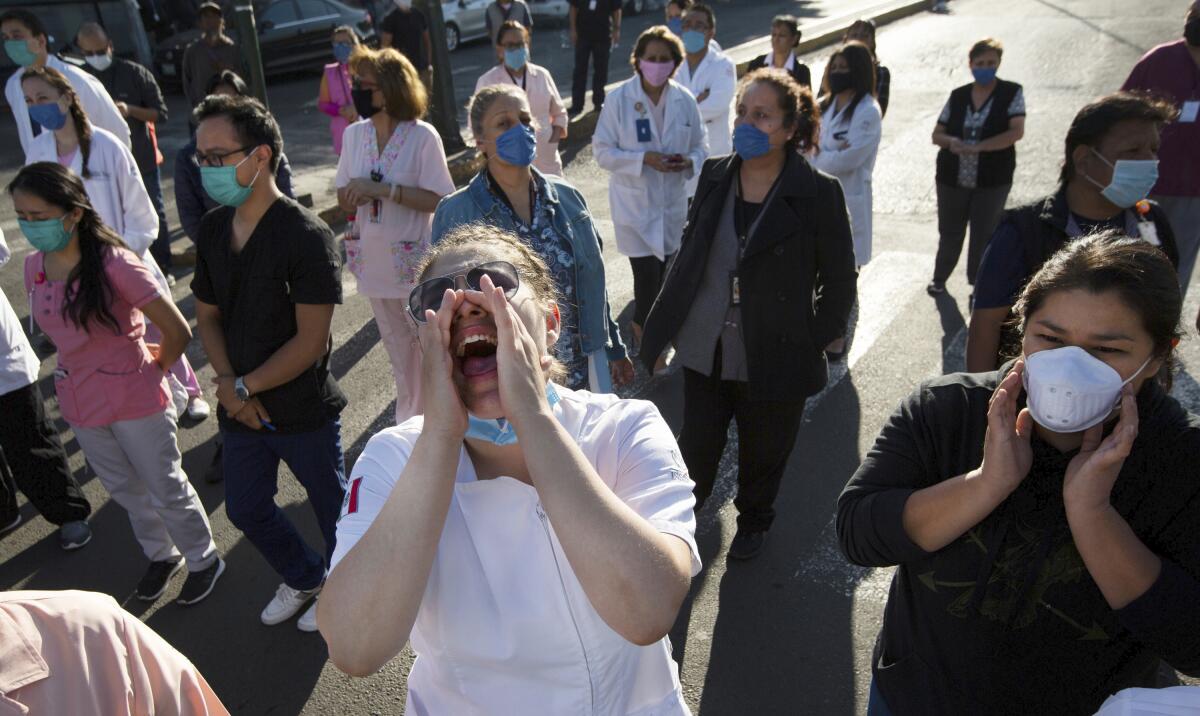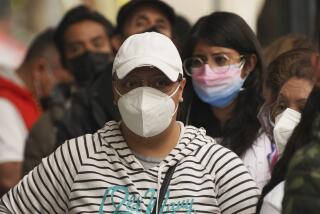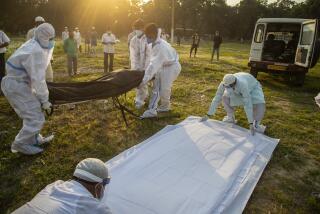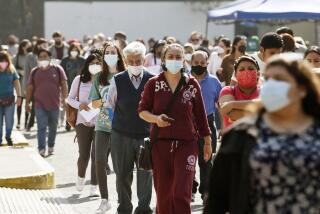Mexico health workers demand more protection as COVID-19 toll in their ranks climbs

- Share via
MEXICO CITY — The emergency room doctor shielded his wife and son from his growing unease about a lack of safety gear at the public hospital where he regularly treated coronavirus patients.
He focused on caring for the sick while insulating his family, following a strict regimen for cleanliness at home — leaving shoes outside the house, diligently bathing and washing clothes, disinfecting the car and sleeping alone in a spare bedroom.
“My husband was dedicated to doing all he could to save his patients,” Patricia Bravo said recently by telephone. “He would start talking about how there wasn’t enough protective material, but when he saw the look of concern on my face he would change the subject.... He was always worried about us.”
Her husband, Dr. Daniel Leglisse, died April 16 of complications from COVID-19. He was 47.
Later, his wife and son would learn more about the extent of Leglisse’s on-the-job exposure, and the significance of his efforts to protect them.
Leglisse is among at least 149 healthcare professionals in Mexico who have succumbed to the virus, according to the country’s health ministry. The casualty numbers among medical personnel — they account for more than 1 in 5 of all confirmed COVID-19 cases in the country — are at the core of a controversy about whether Mexico is doing enough to protect front-line caregivers facing great risks of exposure.
Healthcare workers in many nations, including the United States, have cited a lack of adequate protective equipment. But protests from health personnel have occurred at hospitals across Mexico and have persisted even as authorities say sufficient safety gear is available.
Overall, Mexico reported more than 74,500 confirmed cases of coronavirus and more than 8,100 deaths as of Tuesday. The United States had more than any country, with more than 1.6 million cases and in excess of 98,900 deaths.
More than 11,000 Mexican healthcare workers have tested positive for the coronavirus, according to government statistics. An additional 8,275 cases among Mexican health workers were labeled “suspicious,” awaiting lab results.
Doctors account for more than half of the coronavirus-related deaths among health personnel in Mexico, about 55%, while nurses represent 17%. The remaining 28% includes ambulance workers, maintenance staff, lab technicians and others.
The contagion has battered healthcare workers in many countries, including the United States, where the Centers for Disease Control and Prevention reported at least 62,344 coronavirus cases among U.S. health personnel as of Tuesday, including 291 deaths, though the CDC acknowledges an undercount.
There is no nation-by-nation breakdown of health professionals stricken by COVID-19, making it difficult to assess whether Mexican caregivers are faring worse or better than counterparts elsewhere.
In Mexico, there is a disconnect between healthcare workers’ persistent complaints about a lack of safety equipment and government assurances that all is well.
Since the first coronavirus case was recorded in Mexico in late February, doctors, nurses and others have regularly taken to the streets to protest a lack of sanitary gear. Many hospitals have seen outbreaks, exacerbating an ongoing shortage of medical personnel as many hospitals are inundated by new coronavirus patients.
On Monday, medical staff protested outside the capital’s prestigious National Institute of Respiratory Illnesses. Nurses said they were being forced to reuse masks and gowns rather than being provided with new ones on a daily basis, as experts recommend.
“I don’t want to be contaminated!” the protesters chanted, asserting that the equipment-recycling mandate belied their official designation as “heroes” by President Andrés Manuel López Obrador.
“Medical personnel who die are not heroes — they are the victims of a disgraceful health system!” read a banner hoisted by one nurse. “Don’t hide reality.”
The protest came after the coronavirus-related deaths this month of two staffers — Dr. Rodolfo Jiménez Sosa and Patricia Hernández Gúzman, a nurse — at the nation’s preeminent hospital for respiratory ailments.
Dr. Hugo López-Gatell, the undersecretary of health who heads the country’s coronavirus response, dismissed the complaints as “disinformation or information not completely connected to reality.” He denied that masks were being recycled.
“We no longer have supply problems,” López-Gatell told reporters Monday.
Leglisse died at the General Hospital in Mexico’s City’s Tacuba district, the institution where he had worked for 13 years. It is part of the giant State Employees’ Social Security and Social Services Institute, known as ISSSTE, which serves government workers.
Three days after Leglisse’s passing, Olga Blandina, a popular nurse at the same hospital, died of complications from COVID-19. The two fatalities — along with the earlier death of a staff pediatrician — detonated long-simmering indignation.
“Health personnel are at war without arms,” read a placard hoisted by a nurse during a protest outside the hospital.
In response, management denied any equipment deficit. The hospital director, Juan Carlos García, said that Blandina had no contact with COVID-19 patients, suffered from hypertension and may have contracted the coronavirus “from people who traveled to Europe.”
Blandina, 56, had worked at the hospital for 30 years.
“A tireless lion, always optimistic, with much magic in your heart,” wrote one mourner on Facebook about Blandina. “All the PAIN I feel about your DEATH is transformed into anger ... how to protect yourself if they don’t give you adequate equipment.”
In recent weeks, Mexican authorities have hailed the arrival of more than a dozen jumbo jets ferrying tons of supplies from China. But practitioners call much of the gear unusable — wobbly face shields, flimsy gowns and boot covers, and slender masks providing minimal protection. Many workers purchase their own equipment online or from local distributors.
“They can bring in hundreds of face masks, but if they are of bad quality, they’re useless,” said Bravo, Leglisse’s widow, a pediatrician in private practice. “It’s incredible that people have to go out and pay [for equipment] just to protect themselves.”
The virus is not the only peril facing Mexican caregivers.
Scores of assaults on stigmatized health professionals have been reported, including cases of nurses being sprayed with bleach. In some cases, distraught relatives of coronavirus victims have forced their way into hospitals, angrily confronting medical staff.
And, last week police in Mexico City busted an extortion ring targeting nurses and others who had come from northern Mexico to help fill the gap left as thousands of health workers have become infected and had to leave hospital jobs.
Healthcare personnel have taken to forming impromptu memorial honor guards, cheering and blasting ambulance sirens in farewell gestures as deceased colleagues make a final exit from hospital premises.
Bravo, 47, met her future husband when both were medical students at the National Autonomous University of Mexico in the capital. They married 19 years ago, after graduation.
The onslaught of coronavirus cases was a daunting challenge for her spouse, even after his more than a dozen years as an emergency room physician.
“He kept caring for all the patients who were arriving to the emergency room, but he lacked safety equipment,” she said. “What he tried to do was protect us.”
Leglisse had no delusions about the perils he faced as infected patients began to arrive daily.
“All of our colleagues know the risk, and that’s why they keep demanding protective material,” Bravo said. “They need to change their equipment every day. Now they give them equipment to use all week.”
By April 6, Leglisse had developed a bad cough. He transitioned from doctor to patient. He tested positive for COVID-19 and was placed on a ventilator.
“His companions in the hospital did everything they could for him,” said Bravo, who was unable to visit in his final days because of the risk of infection.
On April 16, the hospital director called and said that Leglisse had died.
Since then, Bravo and her son, Daniel de Jesús Leglisse Bravo, 17, have been in isolation at home. Masks and other equipment ordered by her husband online for use at the hospital continue to arrive at the house. Neither she nor her son has contracted the virus, she said.
“We didn’t get sick because of all he did to protect us,” she said.
After his death, she said she heard from a co-worker that Leglisse had shared with colleagues in a private chat his frustrations about lacking serviceable protective gear as he placed COVID-19 patients on ventilators.
“I don’t want to delve into it or investigate more because at the end of the day that won’t bring him back,” said Bravo, her voice breaking. “My hope is that what I am saying will make authorities aware of the need for sufficient and better equipment, so there won’t be many more families suffering like we are, mourning for my husband and all the martyrs who gave their lives to save others.”
McDonnell is a Times staff writer and Sánchez a special correspondent.
More to Read
Sign up for Essential California
The most important California stories and recommendations in your inbox every morning.
You may occasionally receive promotional content from the Los Angeles Times.










